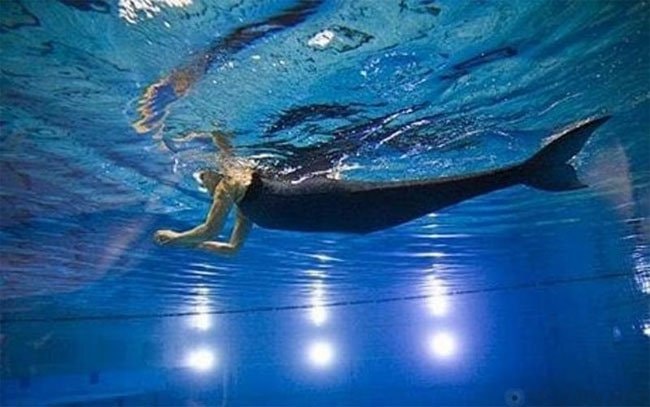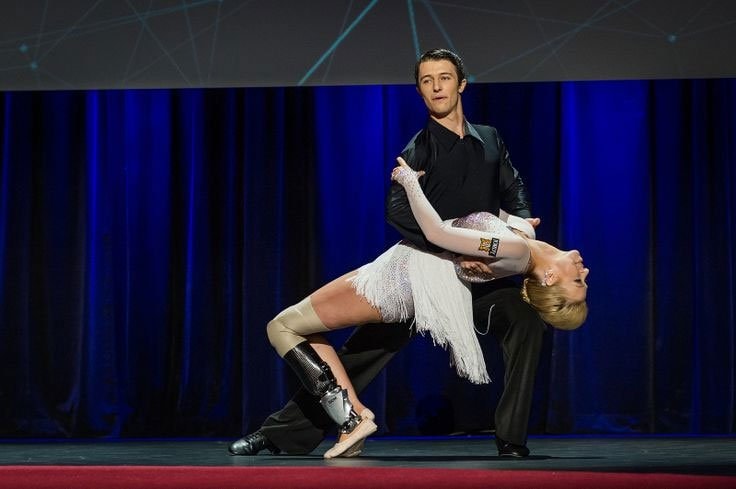Technology helps people with no legs dance and swim like fish
Now humans have created replacement parts. It is the result of bionic inventions, bringing a better life to the sick.
Tail helps people with no legs swim like fish
Scientists have created a “tail” that allows Nadya Vessey, a woman in Auckland, New Zealand, to swim like a fish. Nadya Vessey was born with a condition that forced her to have her legs amputated and use prosthetics.
Nadya often goes to the swimming pool and one day, by chance, a stranger saw her wearing a prosthetic leg and wondered why she was still swimming in such conditions.
 |
| The "tail" helps Nadya Vessey, a woman in Auckland, New Zealand, to swim like a fish. |
Scientists have created a “tail” that helps Nadya Vessey, a woman in Auckland, New Zealand, swim like a fish.
Nadya Vessey joked that she was a mermaid. This prompted Nadya to contact Weta Workshop, a company that specializes in film special effects, to order a tail. Thanks to that, Nadya was able to swim comfortably in the pool like a mermaid.
This bionic tail allows Vessey to swim with ease and grace, not unlike the mythical creatures. It is fully constructed with both the fins and tail made of polycarbonate, the fins are digitally printed so they are very difficult to detect.
As a result, despite no legs, Vessey can still walk normally and swim. Thanks to the bionic tail, Vessey can even participate in triathlon (3 combined sports).
Bionic ankle
According to Hugh Herr, Director of the Biomechatronics Group at the Massachusetts Institute of Technology (USA), biomedical technology is developing rapidly, many diseases related to physical or disability will soon be overcome. Many disabled people have been restored to the same abilities as healthy people.
Take the case of dancer Adrianne Haslet-Davis. A former professional dancer, Adrianne lost part of her leg in the Boston Marathon bombing.
Immediately after the accident, Adrianne was quickly taken by ambulance to Boston Medical Center. In the car, Adrianne tried to tell the nurse that she was a dancer, to try to save her legs, but to ensure her life, the doctors were forced to amputate half of her lower left leg.
 |
| Thanks to a bionic ankle, Adrianne Haslet-Davis can still dance normally after having her leg amputated. |
Thanks to a bionic ankle, Adrianne Haslet-Davis can still dance normally after having her leg amputated.
Hugh Herr, who lost his leg in a climbing accident, designed and created an artificial ankle to restore Adrianne's ability to dance.
Hugh Herr and his colleagues have provided prosthetic legs to over 90 people, with customized versions of bionic ankles.
Artificial knee
Technological advances have made it easier for people with disabilities to walk, such as American student Hailey Daniswicz, who lost her lower left leg to bone cancer in 2005. Hailey Daniswicz is training to use this bionic knee prosthesis.
To help Daniswicz walk, scientists chose a human-machine integration solution, using electromechanical signals and computer software to control the new robotic legs, according to Levi Hargrove, a specialist at the Rehabilitation Institute of Chicago Bionic Medical Center (USA).
Electrodes attached to nine different muscles in Daniswicz's thigh act as antennas, picking up electrical signals sent from nerve cells to the muscles. These electrical signals are emitted in certain patterns depending on Daniswicz's intention to move.
Over time, the computer was able to identify these patterns and “guess” the patient’s intention to move. Daniswicz and three other test subjects were able to not only move their legs and bend their knees, but also control their ankles with the bionic knee.
If the project is successful, it is hoped that the bionic knee and limb will revolutionize the field of artificial limbs, helping to improve the quality of life for people affected by illness or accidents.
Biological teeth
It is predicted that the possibility of regenerating teeth and preventing tooth decay with bionic technology will be exciting in the future. Accordingly, dentists will use biological substitutes to solve the problem of tooth decay.
Dr. Ana Angelova Volponi, an American biologist, said that research to create biological teeth is one of the most significant inventions in the field of dentistry, creating a new generation of teeth by using adult gum stem cells.
In particular, thanks to 3D printing technology, humans will create a new generation of teeth that are highly compatible and will not be rejected, helping users feel more comfortable than with traditional dental implant procedures.
According to Khoahoc.tv
| RELATED NEWS |
|---|



